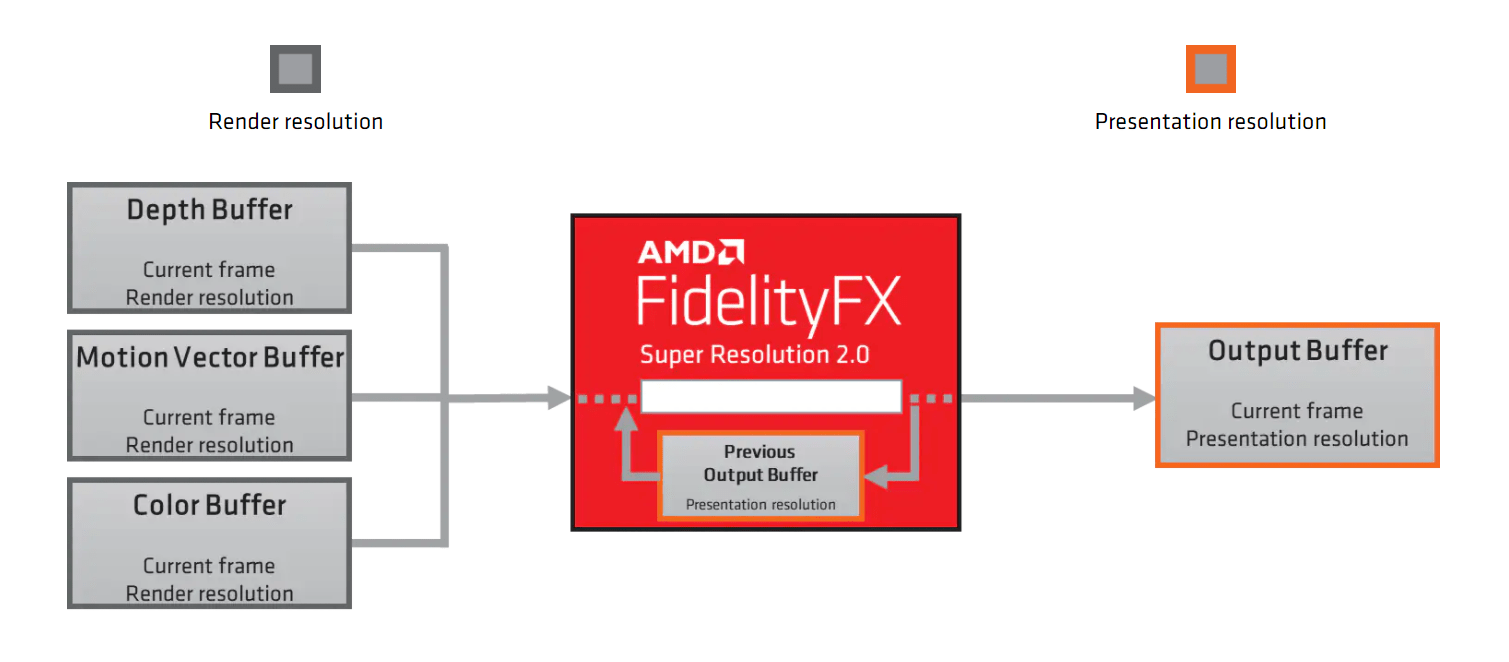FidelityFX Super Resolution 2.0 will be released in the second quarter, which is said to achieve significantly better image quality than FSR 1.0 and, like Nvidia DLSS 2.0, also has a temporal component. Now there is a new entry. GPUOpenwhich reveals more details about FSR 2.0.
DLSS 2.0 style quality modes
As a result, FSR 2.0 will name quality modes slightly differently than FSR and will be based on DLSS. Instead of Ultra Quality, Quality, Balanced and Performance, FSR 2.0 has Quality, Balanced, Performance and Ultra Performance, which seems strange in a direct comparison between FSR 1.0 and FSR 2.0, but makes sense compared to DLSS 2.0.
According to AMD, FSR 2.0 Quality should deliver image quality equivalent to or better than native resolution and reduce render resolution to 67 percent of the set value. So if the target resolution is 3840×2160, FSR 2.0 quality will still render at 2560×1440. FSR 2.0 Balanced is intended to provide a “ideal compromise between image quality and performance gain“ and reduce the resolution to 59 percent. In Ultra HD it would render at 2259×1270 accordingly.
FSR 2.0 performance should have image quality “close to native resolutions with a huge performance gain‘, the render resolution is still 50 percent. Instead of 3,840 × 2,160, it is represented accordingly as 1,920 × 1,080. And it’s supposed to be FSR 2.0 Ultra Performance.”highest performance gain with image quality that remains representative of native resolution” respectively. The rendering resolution is reduced to 33 percent, instead of 3840 × 2160, it is rendered with 1280 × 720. This means that the modes correspond exactly to those of Nvidia’s DLSS 2.0, with the exception of minor deviations. Even if AMD only explicitly specifies Full HD, WQHD, Ultra HD, and 3440×1440 as the target resolution, it can be assumed that FSR 2.0 will support all other resolutions as well.
AMD also mentions other technical details. While FSR 1.0 still works with all major APIs, with FSR 2.0 it seems to be limited, at least temporarily. Because temporary upsampling should initially only work in conjunction with DirectX 12, Vulkan should also be added at a later date. DirectX 11, on the other hand, doesn’t mention AMD.
Depending on the smoothing, the integration takes a different amount of time
Also, AMD developers confirm what ComputerBase initially only suspected: FSR 2.0 completely replaces the game’s own anti-aliasing. For this to work, FSR 2.0 must be deployed much earlier in the rendering pipeline than FSR 1.0. Upsampling requires access to the depth buffer, color buffer, and motion vectors, so it must be built into the game engine. This is also why FSR 2.0, unlike FSR 1.0, cannot be forced into a game (AMD calls it RIS).
-
AMD FSR 2.0 in rendering process (Image: amd)
image 1 of 2
FSR 2.0 should be the easiest to integrate if a game already supports DLSS 2.0, as both technologies have nearly identical requirements. According to AMD, the implementation should take three days, even if it is not clear how many employees were estimated for this (one person would make sense). Also, there will be a plugin for FSR 2.0 for Unreal Engine 4 and Unreal Engine 5, because it should just take a little longer to integrate without prior DLSS integration.
It should take less than two weeks if the game supports TAA and screen resolution independent render resolutions, because then the motion vectors that are important for FSR 2.0 already exist. According to AMD, if TAA is not supported, about three weeks are planned. And if the game doesn’t support TAA and independent rendering and display resolutions, the integration should take four weeks or more.

FSR 2.0 can work together with dynamic resolution
Finally, there are other small details. FSR 2.0 can also handle dynamic resolutions and the developer can also use CAS to improve graphics. AMD recommends that developers integrate a sharpening filter in the graphics menu so that the player can adjust the CAS sharpness according to their own wishes, but this is only optional.
There is also a small preview of the speed to be expected. Since the GDC post referenced by the GPUOpen blog is aimed at developers, AMD doesn’t mention FPS, just the time it takes to calculate FSR 2.0.
Not surprisingly, FSR 2.0 is more computationally intensive than FSR 1.0, and the information is not yet final because it was determined with a version that is not yet finished. For FSR 2.0 quality with the target Ultra HD resolution, the Radeon RX 6800 XT should estimate 1.1 ms, for FSR 2.0 performance less than a millisecond is set. All information is purely related to oversampling and was created without additional sharpening. For the latter, the Radeon RX 6700 XT needs 1.5 ms, with the target resolution WQHD it’s just under 0.7 ms.

Abandoned will support FSR 2.0
It’s also worth mentioning that FSR 2.0, like FSR 1.0, will be open sourced under the MIT license when complete. And in addition to the previously announced Deathloop, AMD has announced a second game with FSR 2.0 support: Forsaken is said to support AMD’s upsampling, but the game won’t be released until October this year.
And last but not least, AMD has provided two more screenshots of Deathloop 2 with the different FSR 2.0 modes, but they are slightly less significant than the images already posted.
-
Ultra HD: native resolution (Image: amd)
image 1 Out of 8

Introvert. Beer guru. Communicator. Travel fanatic. Web advocate. Certified alcohol geek. Tv buff. Subtly charming internet aficionado.



